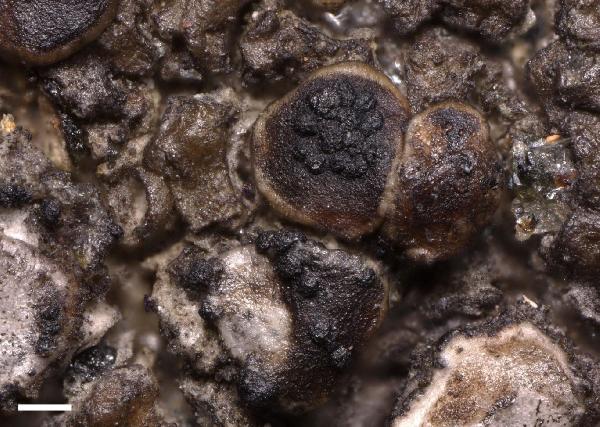Arthonia protoparmeliae Etayo
Guineana, 16: 41, 2010,
Synonyms:
Distribution: S - Si (Brackel & Puntillo 2023).
Description: Thallus inapparent, not lichenized, developing inside the thalli of Protoparmelia-species. Apothecia clustered, arthonioid, orbicular, 0.1-0.25 mm across, strongly convex and subglobose, shining black, at first immersed but becoming sessile or partially erumpent, the lower part cupulate and deeply immersed in the host thallus. Proper exciple thin, dark brown, made of hyphae resembling paraphysoids, K-, N-; epithecium dark brown, I+ red, K/I+ blue, K-, N-; hymenium almost colourless to orange-brown, c.50 μm high, I+ red, K/I+ blue K-, N-; paraphysoids branched and anastomosing 1.5-2 μm thick, the apical cells not swollen, pigmented; hypothecium dark brown, 200-230 μm high, penetrating deeply into the host tissues. Asci 8-spored, clavate, semi-fissitunicate, with a large apical dome, a distinct ocular chamber, without a K/I+ ring-structure in tholus. Ascospores 1-septate, hyaline, ellipsoid, 12-14.5 x 4-5 μm, with a narrow, K/I+ blue gelatinous sheath. Photobiont absent. Spot tests: K-, C-, KC-, P-. Chemistry: without lichen substances. Note: a lichenicolous fungus growing on the thalli of Protoparmelia-species; known from Spain and the British Isles; there is an unpublished record from Italy (Sicily, herb. Brackel).
Growth form: Lichenicolous fungus
Substrata: rocks
Reproductive strategy: mainly sexual
paras Xanthoparmelia-species
Commonnes-rarity: (info)
Alpine belt: absent
Subalpine belt: absent
Oromediterranean belt: absent
Montane belt: extremely rare
Submediterranean belt: extremely rare
Padanian area: absent
Humid submediterranean belt: extremely rare
Humid mediterranean belt: extremely rare
Dry mediterranean belt: extremely rare

Predictive model

Source: Thor, G., Arup, U., Frisch, A., Grube, M., Vicente, R. & Westberg, M. 2023. Padjelanta National Park in Sweden, a lichen diversity heaven. Graphis Scripta 35 (7): 81–125. Oslo. ISSN 2002-4495. - CC BY-4.0
on apothecia of Protoparmelia badia. M. Grube 21-347 (GZU). Scale bar:
250 μm. Photo M. Grube.
Growth form: Lichenicolous fungus
Substrata: rocks
Reproductive strategy: mainly sexual
paras Xanthoparmelia-species
Commonnes-rarity: (info)
Alpine belt: absent
Subalpine belt: absent
Oromediterranean belt: absent
Montane belt: extremely rare
Submediterranean belt: extremely rare
Padanian area: absent
Humid submediterranean belt: extremely rare
Humid mediterranean belt: extremely rare
Dry mediterranean belt: extremely rare

Predictive model

 INDEX FUNGORUM
INDEX FUNGORUM
 GBIF
GBIF


